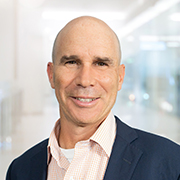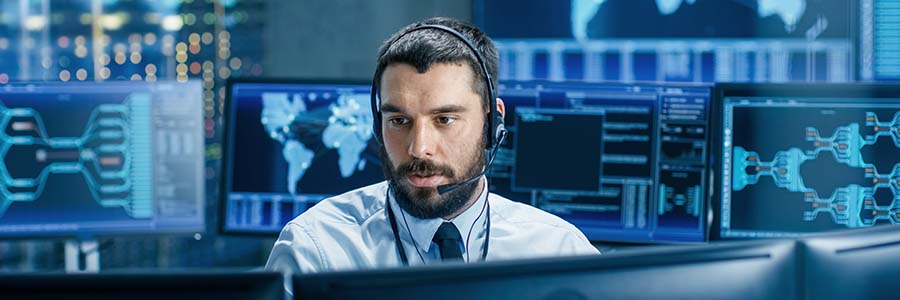Cellebrite's Growth in the Digital Investigations Market
Guest: Andrew Kramer, Vice President, Investor Relations, Cellebrite
Host: Shaul Eyal, Managing Director, Communications, Security and Infrastructure Software Research Analyst, TD Cowen
TD Cowen analyst Shaul Eyal speaks with Cellebrite's Andrew Kramer, Vice President of Investor Relations, from the TD Cowen 53rd Annual Technology, Media & Telecom conference about the company's tailwinds, technology, and business model, as well as current market trends as the company remains focused on driving double-digit growth and profitability. Cellebrite is a Rule of 45 company. We discuss the competitive landscape, which remains largely intact given what we view as high barriers of entry. We continue to view Cellebrite as benefitting from a sizable >$15 billion total addressable market (TAM) opportunity as its SaaS offering and its expanding platform support healthy adoption by its current customer base. We also address Cellebrite's enterprise opportunity as well as recent management changes and discuss cash utilization strategies.
This podcast was recorded on May 29, 2025
Speaker 1:
Welcome to TD Cowen Insights, a space that brings leading thinkers together to share insights and ideas shaping the world around us. Join us as we converse with the top minds who are influencing our global sectors.
Shaul Eyal:
I'm Shaul Eyal, TD Cowen cyber security analyst, and we're joined by Andy Kramer, the VP of IR for Cellebrite. Andy, thank you for joining us.
Andrew Kramer:
Thank you for having me.
Shaul Eyal:
Andy, maybe for the benefit of the audience slightly less familiar with Cellebrite, can you outline for us what is the company doing for a living, the market you guys address?
Andrew Kramer:
Sure.When you think about Cellebrite, you should think about public safety and accelerating justice. Cellebrite, which has been in business for the better part of 25 years, really its bread and butter, is around supporting law enforcement, defense intelligence, corporate customers with their digital investigations, so a platform end-to-end that supports the investigative workflows for law enforcement and other customers in the public sector really around how they collect, review, store, share, and analyze digital evidence.
Shaul Eyal:
How big is the TAM for the markets you guys are addressing?
Andrew Kramer:
We've sized the market at approximately 16 plus billion dollars. It's a market that has been a consistent grower, and what you'll find with Cellebrite is that the highs are never super high, but the lows aren't low. We've delivered very consistent, durable, and profitable growth inside of that TAM. While the TAM is 16 plus billion, the current serve market is considerably smaller. So there's ample room for growth, and look forward to continuing to deliver on that track record.
Shaul Eyal:
Can you maybe provide us with some recent examples where Cellebrite solutions have been used to fight crime?
Andrew Kramer:
I'll give you a couple very high-level episodes where our technology was involved, and it should resonate with folks who are listening to this. Think about last year when President Trump, the first assassination attempt on his life in Butler, Pennsylvania. The FBI confiscated the shooter's cell phone. Cell phone was taken to a field office, which had some of our technology. They actually couldn't open the phone to understand what the motivations may have been.
The phone was then shipped to a different lab with the FBI, and the phone was opened with our software in about 40 minutes. You can think about very high profile cases like that all the way through to current case. In the headlines in Boston, Massachusetts, Karen Reed accused of running down a police officer in Boston. She says she was set up. The cell phone data will play an integral role in either convicting or exonerating her, and it could go either way.
And so you look at 90% of crime today has a digital component. The most common digital device involved in a crime is a cell phone and a smartphone. And so our solutions, the digital forensic component of our platform, which represents the majority of the business today, is a significant competitive advantage for our company and an integral to how law enforcement does their job.
Shaul Eyal:
Before touching on your recent results, can you briefly mention the main products that make up your digital investigation platform? Maybe share with us some high-level capabilities also within the Insight Solution, which is key critical customers.
Andrew Kramer:
There are three primary product families or flagship families within the platform, and the first being Insights, and I'll come back to some of the things that make insights a bit special in the marketplace.But Insights is a digital forensic software that allows a customer to collect and review digital evidence from a wide range of mobile devices. It could be smartphones, could be computers, could be cloud applications. And then from there, the next step in the workflow involves our product, Guardian. Guardian allows the digital forensic units, the examiners in the labs to really manage their workflow from the moment a device is obtained as part of an investigation. Allows them to manage that flow and then store that information, share it securely with investigators, collaborate with those investigators, and in fact give investigators some analytic capability to drill down into that information.
And so as you think about that workflow, complex investigations, typically crimes at scale, involve multiple devices. And so how do you understand the connections between different suspects, different potential victims, witnesses in the context of a large-scale investigation when there are multiple devices obtained? That's where our Pathfinder product comes into play. It's a multi-device AI-powered analytic solution that really allows you to understand those connections to really mine... To set up your narrative and to mine all of that huge volume of information for the golden evidence that will help convict those suspects.
And so when you think about the Insights product and what it does, three really important capabilities. Access, so 60-plus percent of the phones that come into the lab are locked. If the user is unwilling or unable to provide the password, we have capability that allows for circumnavigating the security on a phone. And then the other two capabilities that are equally as important, extraction, being able to take all of the data off of the phone, hidden data, deleted data, geolocation data, data that's not connected to the operating system, could be tokens to all of the passwords on your social media sites, extract all of that data, and then decode. When you extract, you extract in ones and zeros, it's binary code, you then need to convert that back into human-readable, actionable, and defensible information.
Shaul Eyal:
Cellebrite showed healthy first quarter results with rule of 45 metrics. Can you provide more granularity on the ARR growth during the first quarter? How much of that growth was driven by Opsil's versus Du Logos?
Andrew Kramer:
With Cellebrite, we're very fortunate to have an extensive 7,000 plus customers around the world, 5,300 in the public sector, 1,700 plus in the private sector. And so much of our growth comes from the installed base of customers. A little less than 2% will come from new logos. So we continue to acquire new customers, but the balance of our growth comes from upgrading, upselling and cross-selling the platform into that installed base. And so within the Insights family, we're going through an upgrade cycle where customers are migrating and upgrading from our legacy solution to the new Insights offering, which is a much more powerful, much more valuable set of capabilities that are bundled together. And then we've got the classic upsell within Insights for customers that want to obtain lawful access to devices, unlock a locked device. We have a capability that we sell to them as a module within Insights. And then there's the classic cross-sell upsell motion around Guardian and Pathfinder. Layer in on top of that, some expansion within the private sector, price increases and increased user base. All of that contributes to our growth.
Shaul Eyal:
Back in the fourth quarter of 24, on the heels of DOGE and growing macro uncertainty, you indicated potential softness with lack of personnel at times to process purchase orders. That has seemed to evaporate when listening to your first quarter public safety commentary. Can you provide us with more color on that specific point?
Andrew Kramer:
So there's a lot of change happening within our US federal customer base and when that's an important part of our constituents in terms of the customer base represented around 17% of our ARR. And that change is both top down and to a certain extent bottoms up. So you think budget under a lot of pressure, think change in administration, new leadership of wide range of agencies, new individuals brought underneath those leaders, smaller agencies may be unsure what their destinies are. And so all of that is playing a role in the spending activities of our customers in the federal space. Now, fortunately, the first half of the year tends to be a little bit softer in terms of net new buying activity. And so what we saw in Q1 and we'll see more of in Q2, is deferrals on spending decisions. But we do expect that our second half will be a better showing from our U.S federal customers.
And as you think about some of the budget challenges that they have, the House recently passed the president's legislation. It's now in the Senate where it'll be further reviewed and probably modified, but within that legislation are significant funds for both Department of Defense as well as for a wide range of civilian agencies, whether it's Secret Service, Department of Justice, Homeland Security, DEA, that should provide the financial flexibility to help our customers feel like they can move forward with the projects where our technology is going to be instrumental to them.
Shaul Eyal:
And maybe in that respect, can you talk to us about the pipeline of opportunities you're seeing and how is that developing?
Andrew Kramer:
If you look at the U.S federal space, our pipeline was quite healthy as we started the year. It's a pipeline that today is meaningfully larger. Same thing in Europe. In Europe we had a fairly, I'd say, soft first quarter to start the year. We made an investment last year in both in our sales infrastructure, so onboarding more sales capability so that we could better optimize our coverage across Europe. And that's coincided with shifts in spending. So if you think about what's happening geopolitically, there's more dollars.
Europe needs to own their defense. The US has made it clear to across the European Union that they need to pony up more money to secure their borders, to support their military activities around NATO. And so we've seen money shift from public safety into defense and intelligence and our sales people are going where the money is. So while Q1 wasn't where we wanted it to be, Q2 should be an improvement. Still not where we necessarily want it to be, but that should be a continued progression into the second half of the year. So overall, I think Latin America is performing well. Asia Pacific is performing well. US state and local is doing quite well. So I think all of the signs are lining up for an improvement in the growth rates in the absolute dollars of ARR that we bring in as we look to the second half of the year.
Shaul Eyal:
From an R&D standpoint, you're always faced with new model releases on the cell phone, on the mobile front. Can you talk about your success with the latest iPhone and how your work with the iPhone iOS differs from your work with Android?
Andrew Kramer:
I think what's important to keep in mind as you think about the different phone OEMs that are out there is that globally, Android has the largest share of the market. And so what we want to make sure that we can do from a coverage perspective is the breadth and depth of our coverage continues to be unmatched in the industry, whether it's Android and all of the different phone OEMs who customize Android for their particular phone models or Apple.
And so it's not only the latest, greatest new phone models that are introduced and the upgrades to the new operating systems, but you've got to have that back catalog of coverage because if the phone in question was a Samsung Galaxy from four years ago, that's the one that matters to law enforcement. And so the barriers to entry continue to get high and sort of higher each year. And as you think about the new phone models that are introduced, it's an evergreen challenge for our business. The OEMs introduced new phone models, they introduce upgrades to their operating systems, and we've got to go make sure that our solutions still do the job. And so that challenge never ends. Sometimes where the changes are minimal and we can deliver a solution day one-ish, other times it's going to take us a quarter or two or three. And so we continue to make progress on both the Apple iOS front as well as on the Android side of things.
Shaul Eyal:
Gen AI has been topic du jour during this conference and over the cost of the past 18 to 24 months. Can you talk about your investments in AI and how AI is used across the platform, whether it's in sites, Pathfinder and Guardian?
Andrew Kramer:
I think that there's AI and machine learning built into all three of those flagship solutions. Because at the end of the day, AI is an enabler for productivity and efficiency. It enables automation. It enables insights that allow the individuals who are using our solutions to be much more efficient, much more productive with their work. And so when you think about those capabilities, whether it's image classification, whether it's chat summarization, whether it's browsing history analysis, things that might be part of our Guardian solution or as part of Pathfinder language translation, because the language of crime is A, it's multilingual and B, it's unique to itself. Criminals use their own coded language depending on what type of prime they're looking to commit.
And so as you think about those different dynamics, AI is definitely an enabler, but it needs to be paired with human engagement. So humans are in the loop no matter what. And so as you think about what we're able to do, whether it's chat summarization or browsing histories, we're providing the links back to the original source material. And while an AI is to the investigator to come to their conclusion, ultimately the investigator, him or herself, needs to do that work themselves.
Shaul Eyal:
Who do you view as your chief competition? Why do you customers choose Cellebrite and are you seeing any change within a competitive landscape? You've mentioned before high barriers of entry. So I would imagine we're not seeing so many newcomers into that well-established arena.
Andrew Kramer:
Correct. It's interesting. Cellebrite's both a verb and a noun for our customers, particularly those in the digital forensic units. You celebrate a device, you get access to it, you do the extraction, you create a Cellebrite report. And so we're very fortunate to be a trusted partner in the market and technology leader, particularly in digital forensics. But we are the only solutions provider that has a true end-to-end platform. And so while we have competition in each of those product areas, there is no vendor that can go end-to-end like we deal. And so as you think about those competitive dynamics, we certainly have high regard for our competitors in digital forensics. It's a multi-vendor environment, so the larger the customer, the more likely they are to have a myriad of tools at their disposal. And I think for us, we want to be primary. We definitely want to be primary for mobile given how ubiquitous mobile phones are in a crime. It's by far the single most common device.
And so we want to be the trusted partner on, particularly around mobile and particularly around the decode. So even when a customer doesn't use our extraction tool, then they may want to use a competitor for any number of reasons, they'll export that extraction information into our decoding engine to better understand what's on that device. And so that sets us up very nicely. When it comes to evidence management and our Guardian solution, while we do have competition there, a lot of it's greenfield. We're displacing the USB drives so we don't have to win business from the competition and take away business. But what we really need to do is help the customer get comfortable with using a cloud-based solution and really sort of changing their mode of operation from what they've always done to something that's new and really makes a very profound difference in their chain of custody.
Shaul Eyal:
Andy, thank you so much for joining us. Good luck and enjoy the conference.
Andrew Kramer:
Thank you so much.
Speaker 1:
Thanks for joining us. Stay tuned for the next episode of TD Cowen Insights.
This podcast should not be copied, distributed, published or reproduced, in whole or in part. The information contained in this recording was obtained from publicly available sources, has not been independently verified by TD Securities, may not be current, and TD Securities has no obligation to provide any updates or changes. All price references and market forecasts are as of the date of recording. The views and opinions expressed in this podcast are not necessarily those of TD Securities and may differ from the views and opinions of other departments or divisions of TD Securities and its affiliates. TD Securities is not providing any financial, economic, legal, accounting, or tax advice or recommendations in this podcast. The information contained in this podcast does not constitute investment advice or an offer to buy or sell securities or any other product and should not be relied upon to evaluate any potential transaction. Neither TD Securities nor any of its affiliates makes any representation or warranty, express or implied, as to the accuracy or completeness of the statements or any information contained in this podcast and any liability therefore (including in respect of direct, indirect or consequential loss or damage) is expressly disclaimed.

Managing Director, Communications, Security, and Infrastructure Software Research Analyst, TD Cowen

Shaul Eyal
Managing Director, Communications, Security, and Infrastructure Software Research Analyst, TD Cowen

Shaul Eyal
Managing Director, Communications, Security, and Infrastructure Software Research Analyst, TD Cowen
Shaul Eyal is Managing Director and Senior Analyst covering the Communications, Security, and Infrastructure Software sectors and is one of Wall Street’s leading experts in those spaces. He started his equity research career at Oppenheimer & Co. covering Israeli technology related equities and expanded his research focus to cover the security and communication software universes.
Shaul holds an M.B.A. from Fordham University and an LL.B with honors from Oxford Brookes University. He served for five years in the Special Forces of the Israeli Defense Forces, where he held the rank of Lieutenant.






